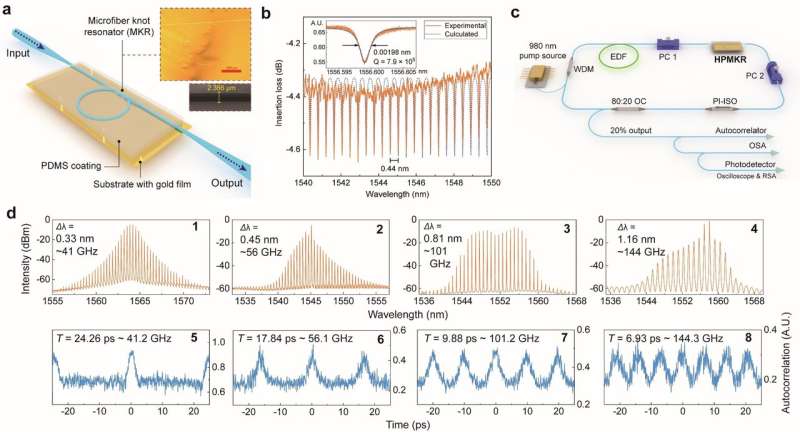A new approach to achieving stable, high-repetition-rate laser pulses

High-repetition-rate pulsed lasers serve a wide range of applications, from optical communications to microwave photonics and beyond. Generating trains of ultrashort optical pulses commonly involves locking phases of longitudinal laser cavity modes. In 1997, a mechanism based on dissipative four-wave-mixing (DFWM) was demonstrated with key components comprising comb filters and high-nonlinearity elements. Since then, demonstrations of high-repetition-rate pulse trains adopting DFWM have exploited various types of comb filters and nonlinear components.
In 2012, Peccianti et al. proposed a stable 200-GHz ultrafast fiber laser based on a silica microring resonator that serves as an integrated comb filter to boost DFWM mode locking. But the silica scheme is costly and involves coupling loss between the fiber and the silica waveguide. Therefore, a low-cost all-fiber resonator for generating high-repetition-rate laser pulses using DFWM remains highly desirable. Nevertheless, the absence of strong nonlinearity in standard optical fibers has been a significant barrier to triggering high repetition rate short pulse generation—until now.
Hybrid plasmonic microfiber knot resonator
A team of researchers from Nanjing University and Shanghai University recently demonstrated a new approach to achieving stable, high-repetition-rate laser pulses through DFWM, based on a novel microfiber device: a hybrid plasmonic microfiber knot resonator (HPMKR). Their open-access research appears in the latest issue of Advanced Photonics.
Given their strong evanescent field, low insertion loss, and compatibility with all-fiber optical systems, microfiber-based devices are widely used—especially for microfiber resonators. With significantly small diameter and air cladding, tapered microfibers exhibit high nonlinearity compared with common single-mode fibers (SMFs). For example, the nonlinear coefficient γ of a piece of microfiber with 2-μm diameter is calculated to be approximately 50 times that of the standard SMF (at 1550 nm).
The key device of the work, the HPMKR, includes a knot resonator formed from tapered microfiber that is attached to a glass substrate with a gilded surface and then packaged with polydimethylsiloxane (PDMS) polymer. The practical Q-factors of common microfiber resonators are well below 104 but in this work, Q was optimized up to near 106 experimentally. Strong surface plasmon polaritons introduced by the fine attachment of gold cause the device to exhibit prominent polarizing features; a maximum polarization-dependent loss (PDL) of 19.75 dB was achieved.
HPMKR laser
In a next step, the HPMKR device was embedded in a standard ring fiber laser cavity. The large PDL of HPMKR led to nonlinear polarization rotation (NPR) within the laser cavity, yielding Q-switched or mode-locked pulses with large instantaneous power to compensate relatively low nonlinearities and excite DFWM in the microfiber. For its versatile role in fiber lasers, researchers termed the laser scheme "NPR-stimulated DFWM."
The HPMKR is not only a broadband polarizing element, but also a high-quality filter and nonlinear element. The laser oscillates in stark contrast to all previous DFWM schemes, where the necessity of extremely high nonlinear elements is removed. The device effectively lowers the bar for achieving DFWM, eliminating the complexity that hindered high-Q (million) device fabrication. A stable pulse train with repetition rates from 41.2 to 144.3 GHz at 1550 nm was achieved.
The innovative research enables potential applications of advanced microfiber resonators in the fields of laser and nonlinear optics, particularly owing to the HPMKR's succinct structure and all-fiber compatibility.
More information: Zi-xuan Ding et al. All-fiber ultrafast laser generating gigahertz-rate pulses based on a hybrid plasmonic microfiber resonator, Advanced Photonics (2020). DOI: 10.1117/1.AP.2.2.026002
Provided by SPIE





















